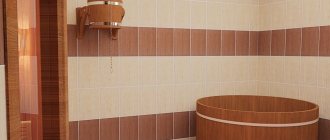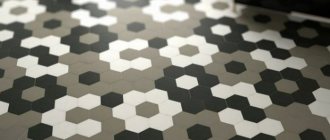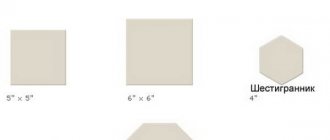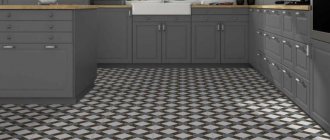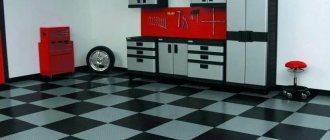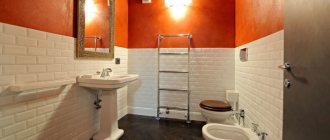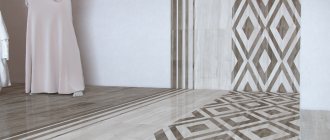One of the latest and, undoubtedly, “long-lasting” trends in the tile industry is volumetric tiles. The mass distribution of three-dimensional tiles is due to a successful combination of circumstances: consumers have fully realized the “tri-dash” delights in various fields, and tile manufacturers have finally mastered the technologies for producing volumetric ceramics.
You can be sure that fashion is not fleeting. There are a huge number of magnificent collections of flat tiles, but the additional dimension, expressed by the inimitable relief of the surface of the ceramics, in many stylistic situations can put any two-dimensionality to rest. Only an understanding of consumer diversity protects us from unconditional categoricalness and hanging victorious laurels on three-dimensional tiles.
What can you do, because even cladding made in a classic style can be richly and appropriately spiced up with structural tiles. In other, more modern design situations, real or visual relief is an indisputable plus for the interior.
Features of volumetric tiles
This building material is made from reinforced concrete or ceramics. The coating of the material is opaque. Its main task is to convey volume through its own texture. Among the rich assortment of relief-type materials, you can choose tile, gypsum and wooden three-dimensional tiles.
According to its texture, 3D tiles can be decorated with the following patterns:
- honeycomb;
- convex hemispheres;
- wave-like overflows;
- plant pattern.
The range is increasing due to the variety of structure. 3D tiles come in glossy, rough and matte.
Despite the many advantages and original design, this material has a drawback. Moisture and dust accumulate on the rough surface, making it more difficult to clean than regular tiles. In addition, it should be taken into account that visually voluminous tiles conceal space.
Video description
This view shows the correct installation of clinker steps and reveals common mistakes:
Grouting joints
The event is carried out to create an aesthetic sealed finish, strengthen the coating and protect the seams. Grouting compounds are available for sale in powder form based on Portland cement with plasticizers. They are diluted in water with the addition of liquid latex. Cement mixtures generate dust during mixing, so be sure to use a respirator.
Grout for clinker Source dd-stroi.ru
Epoxy compounds are sold complete with a hardener. Such materials are used for operation in aggressive conditions relative to load and natural phenomena. Disadvantage: viscous consistency and high adhesion. You need to work with caution, as it will be difficult to wash the grout from the surface.
Grouting is carried out only after the adhesive under the tile has completely dried. The use of semi-dry cement mass allows you to get a rough joint after compaction. More often, the problem is solved using a construction gun for paste solutions, which speeds up and simplifies the process. Here it is enough to squeeze out the mass and remove the dried excess. They also rub the surface by smearing and removing the residue with a rubber spatula or trowel.
Types of 3D tiles
There are a huge number of options for volumetric tiles today. The main emphasis when choosing should be on the original effect, as well as on the room for which you are looking for finishing material.
1. Single-color relief tiles. This type of volumetric tile is a real find for connoisseurs of minimalism. Despite the monochrome color scheme, “stylistic neutrality” does not look boring. This type of cladding material is suitable for the bathroom. In addition, it is appropriate in the design of the kitchen and any room in a modern style.
2. “Under a stone.” Current colors, repeating marble and stone structure, will fit perfectly into any design. 3D stone tiles look beautiful not only in an apartment, but also in a country house, cafe, restaurant.
3. “Under concrete.” Tiles, the texture and color of which resemble concrete, are gaining momentum in popularity. Relief tiles will be an excellent backdrop for hi-tech and loft style.
4. “Under the tree.” Such tiles in three-dimensional format look like real boards and bars. Such material attracts attention; you always want to touch it. Wood-look tiles can be used for zoning. It creates a cozy and warm atmosphere in the house. This solution is suitable for any room, the main thing is to competently develop a design project, providing for harmonious combinations of this material with others. For example, for a bathroom you can buy round tiles and highlight the accent area with a wavy pattern. Streamlined designs will help smooth out the harshness of the interior lines.
How to choose the optimal layout
Before choosing a tile, it is worth drawing a sketch by hand to decide on the type of cladding. To do this, you need to draw a detailed plan of the room with all dimensions and furnishings:
- carefully take measurements of the floor and walls, openings, and indicate the parameters on paper;
- draw up a drawing of the bathroom and be sure to show the location of the doorway, window (if any), all niches and ledges;
- indicate the location of plumbing fixtures, sockets, switches, and pipeline outlets.
Now that the plan is ready, you can choose the optimal layout scheme using sketches with colored pencils. Such a sketch will help determine the best location of decorative elements, places to cut tiles, and problem areas. Be sure to consider the degree of complexity of the work if you plan to do the cladding yourself.
Tile layout options may depend on the geometry of the walls and the presence of protrusions
Correct layout of tiles in the bathroom
Advice. Now there are special programs that allow you to design the layout of the cladding in the bathroom and see what it will look like. Most large construction stores have been offering similar services to their customers for a long time. You can find the program yourself and practice the art of design.
Tile design in different rooms
An unusual solution is panel tiles. It is combined with natural stone, tiles, ceramic or glass mosaics. 3D panel tiles can be used to decorate ceilings in certain areas. The color of the tiles can be any: cream, white, beige, light gray, with a metallic tint.
1. Bathroom. To decorate this room, designers often use materials in marine colors. Blue and turquoise 3D tiles diluted with lush greenery look especially attractive.
2. Living room. For this room, 3D tiles, mostly monochromatic, are best suited. The following patterns will look impressive: branches, foliage, geometry. On a plain background, the wavy texture attracts attention. An aesthetic solution is hexagons, rhombuses, circles that form a single canvas. Black and white 3D tiles fit perfectly into an interior designed in art deco and classic styles. The warm shade of wood fits harmoniously into country style, strict classics and country.
3. Bedroom. Designers advise using embossed opaque tiles for cladding. These can be bulges and roughness, wooden patterned surfaces or a white plaster wave.
4. Kitchen/dining room. The kitchen backsplash can be made from 3D tiles in the art deco style.
Flaws
- One of the main disadvantages of relief tiles is its price. You have to pay for aesthetics and unique style. Purchasing cheap options does not make sense, since they either do not meet quality requirements or do not have decorative properties.
- The inconvenience when cutting relief tiles is a significant disadvantage. Only professionals will be able to solve the problem of matching one part to another. Since the relief in most cases will not match.
- An important factor that can scare away the idea of buying relief tiles will be the difficulty of cleaning. Due to the fact that it has various indentations, washing it will not be an easy task. You will need to purchase a washing vacuum cleaner with special attachments. Or don't wash it at all. :)
Advantages of volumetric tiles
Along with the aesthetic appeal and multidimensional effect, it is worth noting other advantages of cladding with this finishing material:
- anti-slip surface - the material will be relevant for the kitchen and bathroom;
- increased wear resistance is an important criterion for flooring;
- environmental friendliness - the material does not cause an allergic reaction and does not emit harmful substances;
- durability - 3D tiles last for several decades without changing their original qualities.
A part of the wall from floor to ceiling made of tiles will look gorgeous. You can complement the wall with LED lighting or a pendant lamp.
Tips and tricks for laying gypsum boards
Gypsum materials tend to absorb moisture. It can come from both inside the room and outside from the walls. Before covering with gypsum cladding, 1 or 2 layers of moisture-resistant primer must be applied to the walls. Otherwise, wet tiles will swell, change color, and fall off, breaking on the floor.
If the walls were previously covered with lime or paint, you need to get rid of such coating. These materials are short-lived and the elements glued to them will soon fall off.
Existing cracks need to be repaired, leveled, and primed. The wall for gypsum boards should be as smooth as possible, and its surface should be free of dust and grease.
- First you need to carefully study the drawing. It doesn’t hurt to initially lay it out on a dry, flat horizontal surface, then continue laying it out during work, gradually transferring it to a vertical plane and gluing it.
- Many tiles with natural textured patterns have an irregular geometric shape, so it is necessary to monitor the direction of the relief and the absence of gaps at the joint.
It is important to lay out the first row correctly. To keep everything smooth and beautiful, it is convenient to use a laser level. If it is not there, use bubble and marking lace. They start in different ways, depending on the type of tile and its relief.
It is quite difficult to lay out bricks. In this case, it is necessary to calculate the thickness of the seams. It must be 1) the same; 2) the top layer should not be less than half the width of the brick. Placed under the brick from bottom to top; Kasavaga tiles are the opposite.
Photo collection of volumetric tiles
Ceramic tiles with a 3D effect can be found in the WOW, Realonda, Peronda, Equipe, Porcelanosa collections.
Now look at our photo selection. Which options do you like best?
Country of origin and price
Don’t pay attention to the manufacturer’s name; each of them has both bad and good options. You need to look at the country of manufacture
The quality of Russian tiles leaves much to be desired, so it is better not to buy them. Good options can be found from manufacturers from Spain, Italy, Germany, and Portugal. You can also find good options in terms of price/quality ratio among Chinese porcelain stoneware.
Good tiles cost from 900 to 1800 rubles per square. Everything that is cheaper either has a bad appearance or crooked geometry and dimensions. Anything more expensive is basically an overpayment for the brand. If you are doing renovations for yourself and for a long time, then tiles for the bathroom may cost more, but you should not buy cheaper.
Also, for a good repair, you should not take leftovers from the sale. Such tiles will either be defective or there will be few of them: this is usually how the remnants of discontinued collections are sold.
